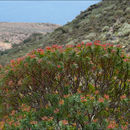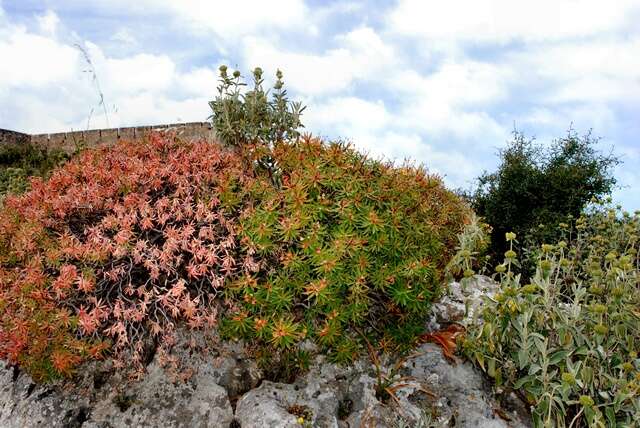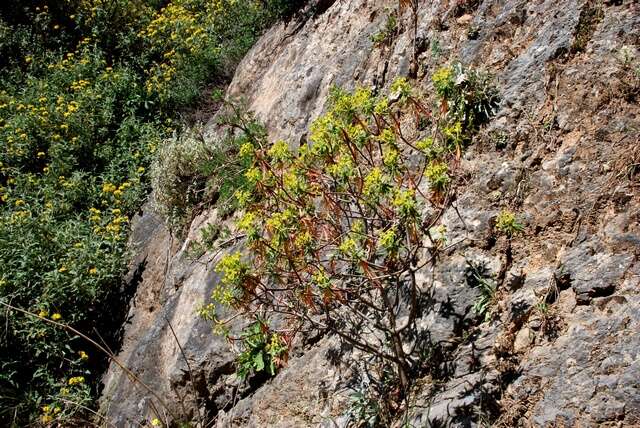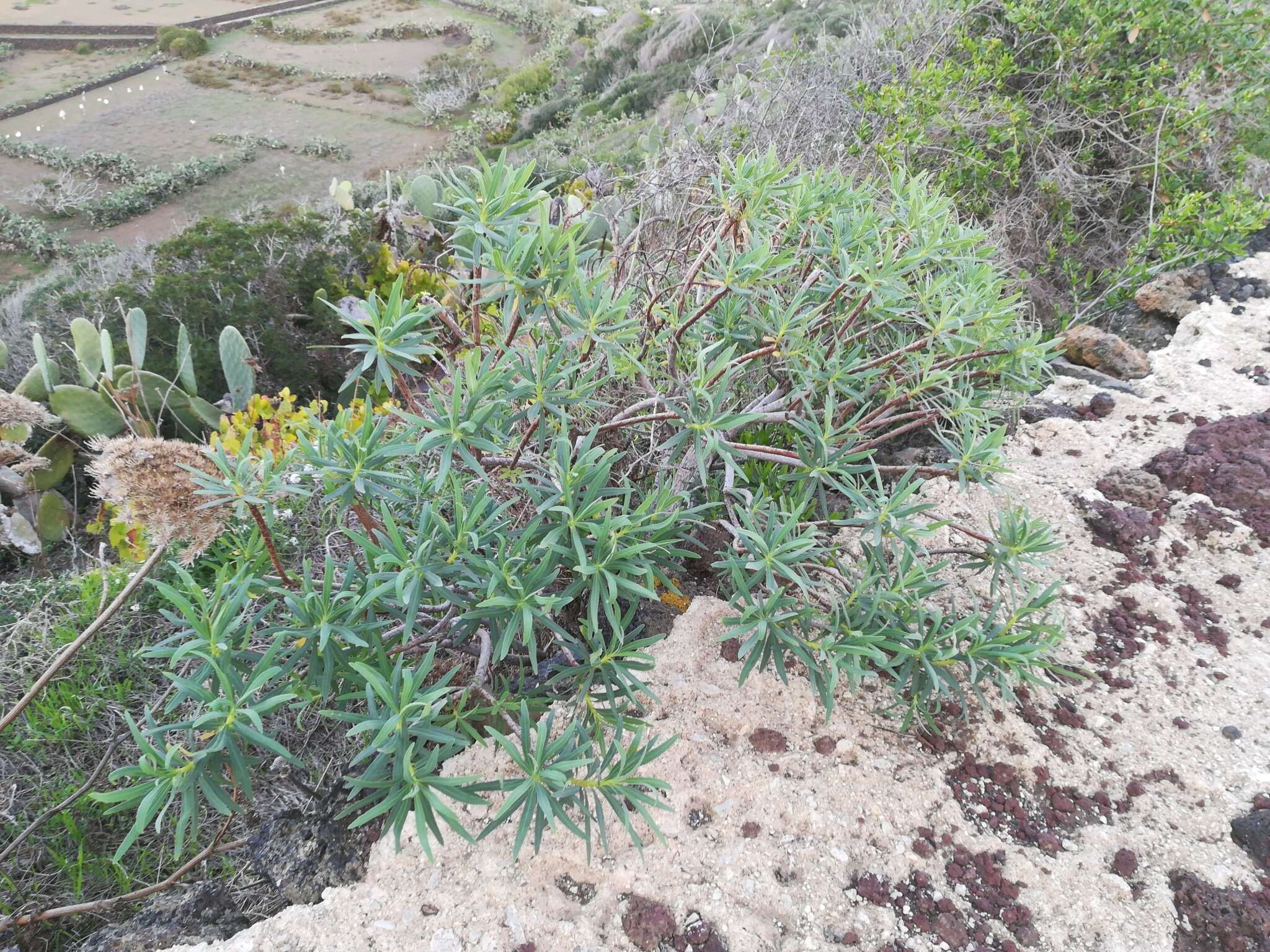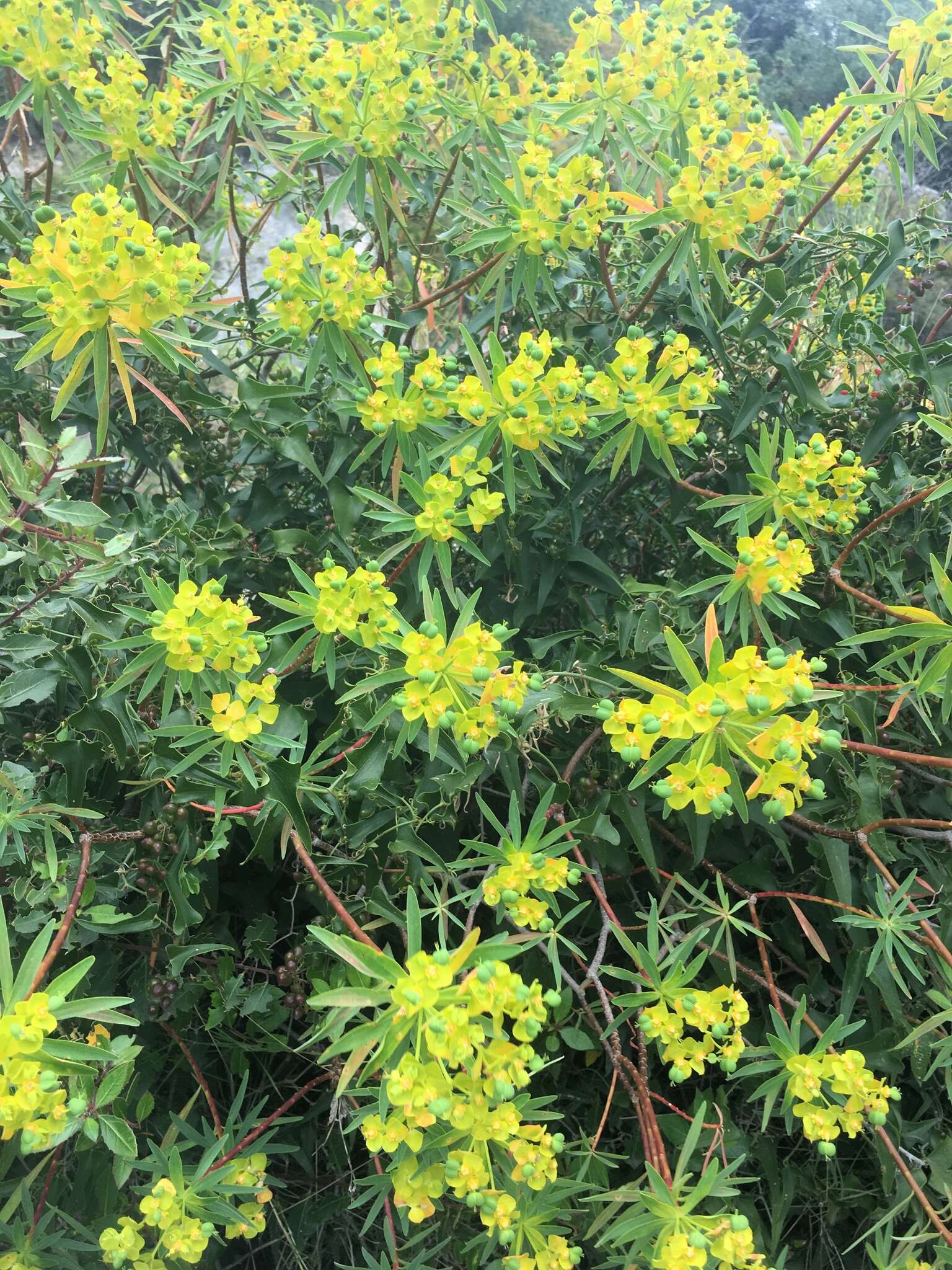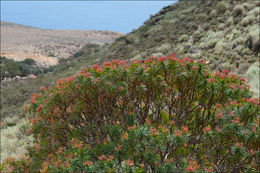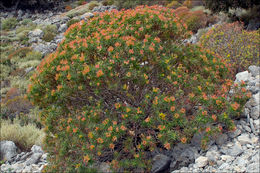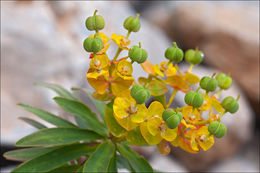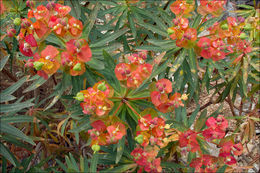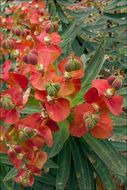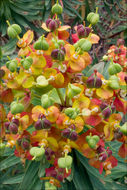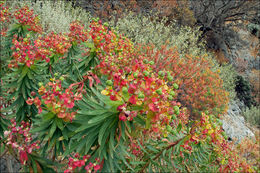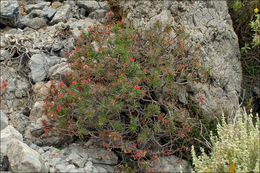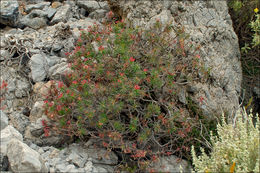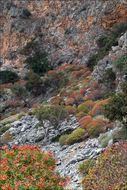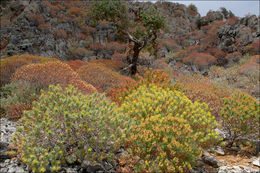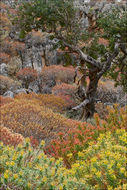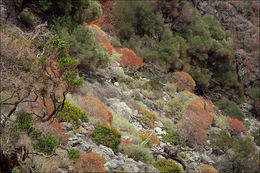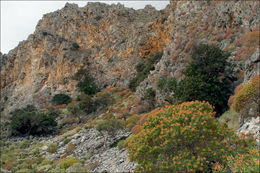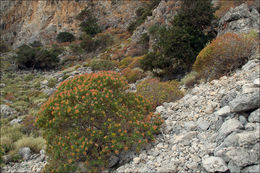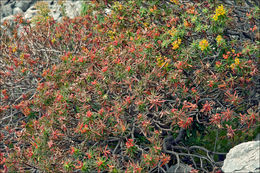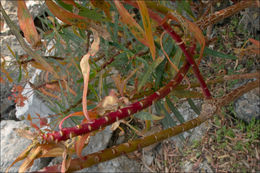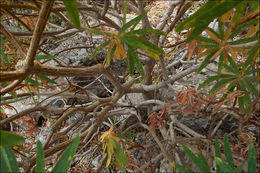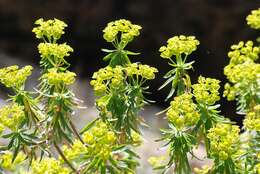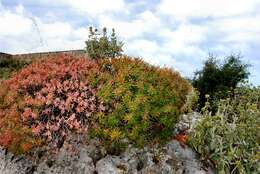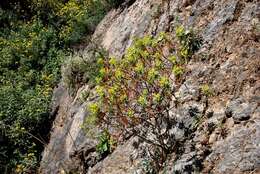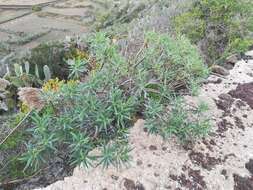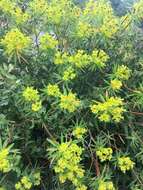-
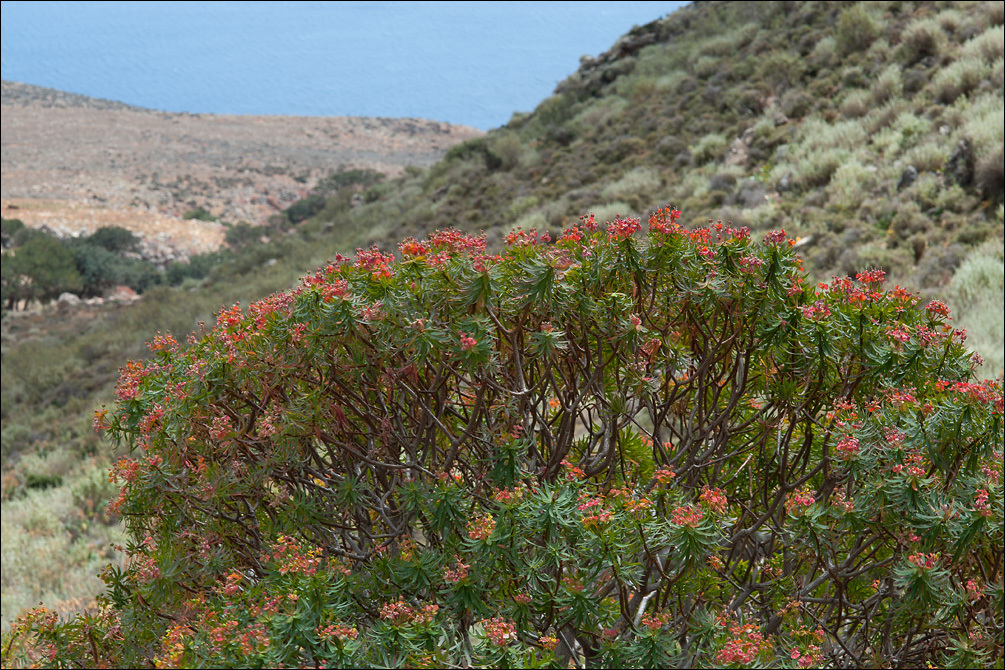
Slo.: no name. - Habitat: stony mountain ravine close to sea shore, calcareous ground, full sun, warm place, south to east aspect, elevation 270 m (890 feet); average precipitations ~ 960 mm/year, average temperature about 18 deg C, Mediterranean phytogeographical region. Substratum: soil among rocks.Comment: Genus Euphorbia is huge. All kind of imaginable plants constitute it. In North and Central Europe they are mostly small and herbaceous and more to the south one goes, more species are woody, bush and tree like. Many of them are very beautiful, either from the standpoint of colors or shapes of leaves or their unusually built flowers.Euphorbia dendroides is spread in all Mediterranean countries except Cyprus. It is one of the most beautiful woody species. Particularly the colors of their flowers and leaves, which are yellow and green in early spring, impress. Toward the end of springtime when higher and higher temperatures and drought push forth they change their color to all kind of orange, red, wine red, brown-violet, before they fall off in summer. Large, up to 2.5 m high, rounded bushes, often forming large colonies in more or less barren rocky mountain slopes turn to marvelous vistas. My trip to this steep, wild, incredible thorny, trail-less ravine of peninsula Korykos in northwest Crete was an unforgettable experienceRef.:(1) I. Schnfelder, P. Schnfelder, Kosmos Atlas Mittelmeer- und Kanarenflora, Kosmos, (2002), p 106.(2) V. Popiomytoglou, Woldblumen Griechenland, Mediterraneo Edition (2006), p 89.(3) M. Blamey, C. Grey-Wilson, Wild Flowers of the Mediterranean, A & C Black, London (2005), p 118.(4) R. Domac, Flora Hrvatske (Flora of Croatia) (in Croatian), kolska Knjiga, Zagreb (1994), p 61.(5) D. Seidel, Blumen am Mittelmeer, BLV (2002), p 215.
-
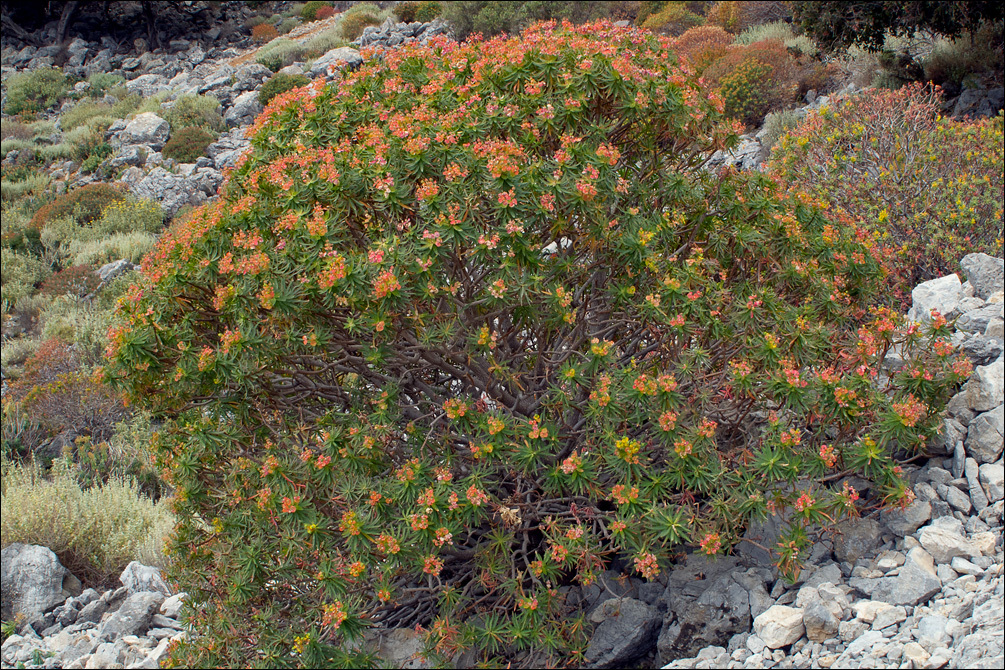
Slo.: no name. - Habitat: stony mountain ravine close to sea shore, calcareous ground, full sun, warm place, south to east aspect, elevation 270 m (890 feet); average precipitations ~ 960 mm/year, average temperature about 18 deg C, Mediterranean phytogeographical region. Substratum: soil among rocks. Comment: Genus Euphorbia is huge. All kind of imaginable plants constitute it. In North and Central Europe they are mostly small and herbaceous and more to the south one goes, more species are woody, bush and tree like. Many of them are very beautiful, either from the standpoint of colors or shapes of leaves or their unusually built flowers. Euphorbia dendroides is spread in all Mediterranean countries except Cyprus. It is one of the most beautiful woody species. Particularly the colors of their flowers and leaves, which are yellow and green in early spring, impress. Toward the end of springtime when higher and higher temperatures and drought push forth they change their color to all kind of orange, red, wine red, brown-violet, before they fall off in summer. Large, up to 2.5 m high, rounded bushes, often forming large colonies in more or less barren rocky mountain slopes turn to marvelous vistas. My trip to this steep, wild, incredible thorny, trail-less ravine of peninsula Korykos in northwest Crete was an unforgettable experience Ref.: (1) I. Schnfelder, P. Schnfelder, Kosmos Atlas Mittelmeer- und Kanarenflora, Kosmos, (2002), p 106. (2) V. Popiomytoglou, Woldblumen Griechenland, Mediterraneo Edition (2006), p 89. (3) M. Blamey, C. Grey-Wilson, Wild Flowers of the Mediterranean, A & C Black, London (2005), p 118. (4) R. Domac, Flora Hrvatske (Flora of Croatia) (in Croatian), kolska Knjiga, Zagreb (1994), p 61. (5) D. Seidel, Blumen am Mittelmeer, BLV (2002), p 215.
-
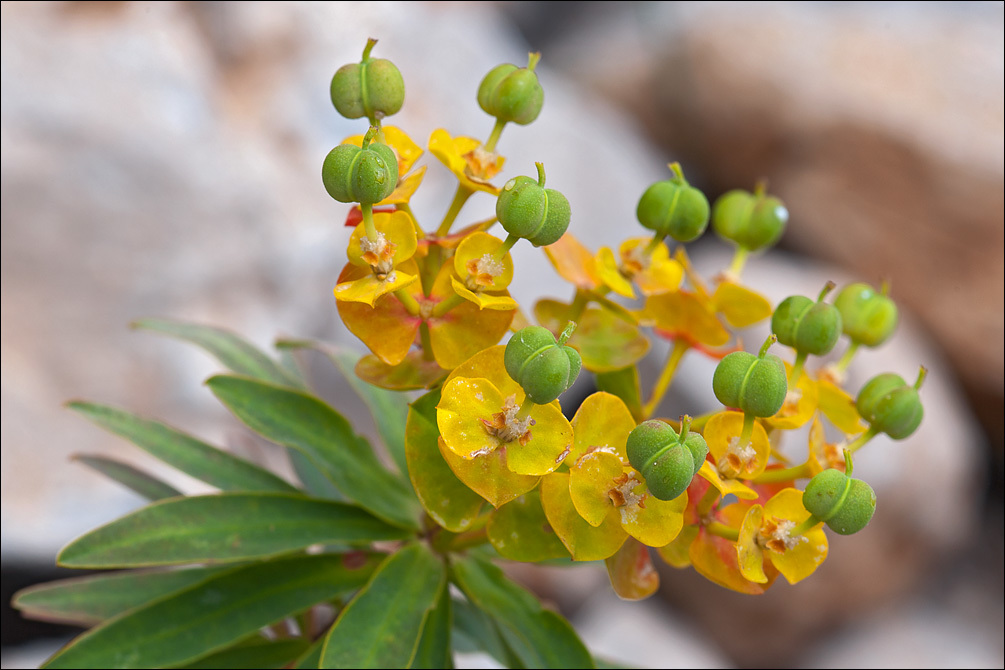
Slo.: no name. - Habitat: stony mountain ravine close to sea shore, calcareous ground, full sun, warm place, south to east aspect, elevation 270 m (890 feet); average precipitations ~ 960 mm/year, average temperature about 18 deg C, Mediterranean phytogeographical region. Substratum: soil among rocks. Comment: Genus Euphorbia is huge. All kind of imaginable plants constitute it. In North and Central Europe they are mostly small and herbaceous and more to the south one goes, more species are woody, bush and tree like. Many of them are very beautiful, either from the standpoint of colors or shapes of leaves or their unusually built flowers. Euphorbia dendroides is spread in all Mediterranean countries except Cyprus. It is one of the most beautiful woody species. Particularly the colors of their flowers and leaves, which are yellow and green in early spring, impress. Toward the end of springtime when higher and higher temperatures and drought push forth they change their color to all kind of orange, red, wine red, brown-violet, before they fall off in summer. Large, up to 2.5 m high, rounded bushes, often forming large colonies in more or less barren rocky mountain slopes turn to marvelous vistas. My trip to this steep, wild, incredible thorny, trail-less ravine of peninsula Korykos in northwest Crete was an unforgettable experience Ref.: (1) I. Schnfelder, P. Schnfelder, Kosmos Atlas Mittelmeer- und Kanarenflora, Kosmos, (2002), p 106. (2) V. Popiomytoglou, Woldblumen Griechenland, Mediterraneo Edition (2006), p 89. (3) M. Blamey, C. Grey-Wilson, Wild Flowers of the Mediterranean, A & C Black, London (2005), p 118. (4) R. Domac, Flora Hrvatske (Flora of Croatia) (in Croatian), kolska Knjiga, Zagreb (1994), p 61. (5) D. Seidel, Blumen am Mittelmeer, BLV (2002), p 215.
-
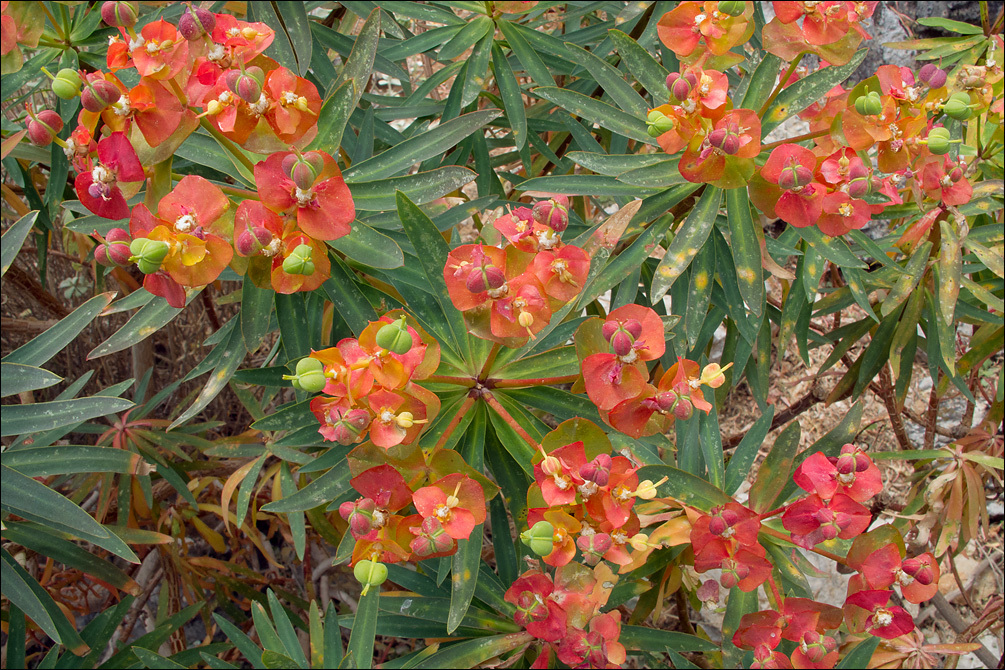
Slo.: no name. - Habitat: stony mountain ravine close to sea shore, calcareous ground, full sun, warm place, south to east aspect, elevation 270 m (890 feet); average precipitations ~ 960 mm/year, average temperature about 18 deg C, Mediterranean phytogeographical region. Substratum: soil among rocks. Comment: Genus Euphorbia is huge. All kind of imaginable plants constitute it. In North and Central Europe they are mostly small and herbaceous and more to the south one goes, more species are woody, bush and tree like. Many of them are very beautiful, either from the standpoint of colors or shapes of leaves or their unusually built flowers. Euphorbia dendroides is spread in all Mediterranean countries except Cyprus. It is one of the most beautiful woody species. Particularly the colors of their flowers and leaves, which are yellow and green in early spring, impress. Toward the end of springtime when higher and higher temperatures and drought push forth they change their color to all kind of orange, red, wine red, brown-violet, before they fall off in summer. Large, up to 2.5 m high, rounded bushes, often forming large colonies in more or less barren rocky mountain slopes turn to marvelous vistas. My trip to this steep, wild, incredible thorny, trail-less ravine of peninsula Korykos in northwest Crete was an unforgettable experience Ref.: (1) I. Schnfelder, P. Schnfelder, Kosmos Atlas Mittelmeer- und Kanarenflora, Kosmos, (2002), p 106. (2) V. Popiomytoglou, Woldblumen Griechenland, Mediterraneo Edition (2006), p 89. (3) M. Blamey, C. Grey-Wilson, Wild Flowers of the Mediterranean, A & C Black, London (2005), p 118. (4) R. Domac, Flora Hrvatske (Flora of Croatia) (in Croatian), kolska Knjiga, Zagreb (1994), p 61. (5) D. Seidel, Blumen am Mittelmeer, BLV (2002), p 215.
-
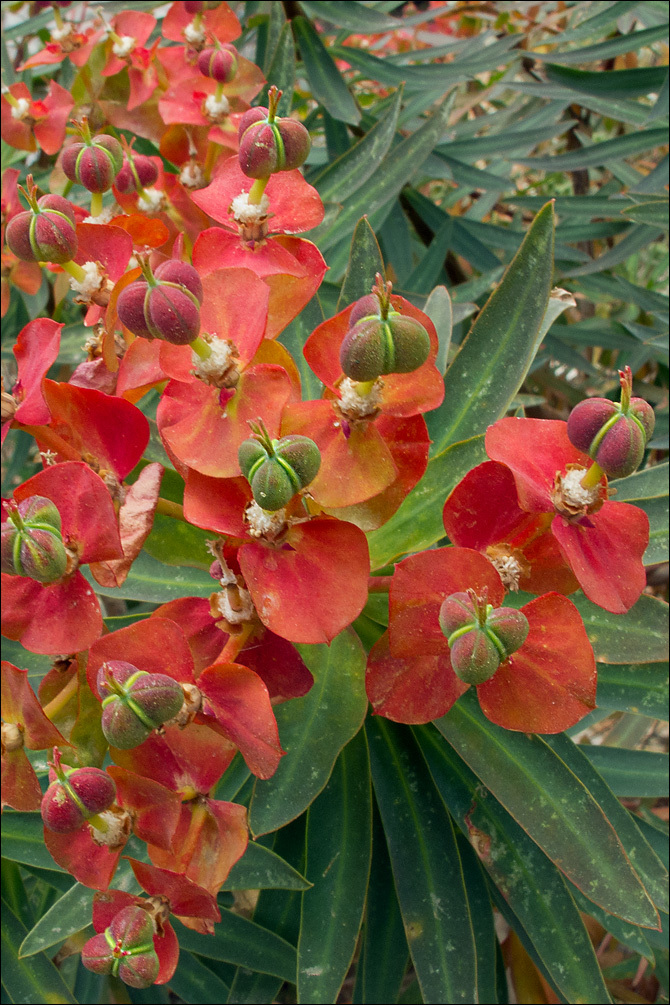
Slo.: no name. - Habitat: stony mountain ravine close to sea shore, calcareous ground, full sun, warm place, south to east aspect, elevation 270 m (890 feet); average precipitations ~ 960 mm/year, average temperature about 18 deg C, Mediterranean phytogeographical region. Substratum: soil among rocks. Comment: Genus Euphorbia is huge. All kind of imaginable plants constitute it. In North and Central Europe they are mostly small and herbaceous and more to the south one goes, more species are woody, bush and tree like. Many of them are very beautiful, either from the standpoint of colors or shapes of leaves or their unusually built flowers. Euphorbia dendroides is spread in all Mediterranean countries except Cyprus. It is one of the most beautiful woody species. Particularly the colors of their flowers and leaves, which are yellow and green in early spring, impress. Toward the end of springtime when higher and higher temperatures and drought push forth they change their color to all kind of orange, red, wine red, brown-violet, before they fall off in summer. Large, up to 2.5 m high, rounded bushes, often forming large colonies in more or less barren rocky mountain slopes turn to marvelous vistas. My trip to this steep, wild, incredible thorny, trail-less ravine of peninsula Korykos in northwest Crete was an unforgettable experience Ref.: (1) I. Schnfelder, P. Schnfelder, Kosmos Atlas Mittelmeer- und Kanarenflora, Kosmos, (2002), p 106. (2) V. Popiomytoglou, Woldblumen Griechenland, Mediterraneo Edition (2006), p 89. (3) M. Blamey, C. Grey-Wilson, Wild Flowers of the Mediterranean, A & C Black, London (2005), p 118. (4) R. Domac, Flora Hrvatske (Flora of Croatia) (in Croatian), kolska Knjiga, Zagreb (1994), p 61. (5) D. Seidel, Blumen am Mittelmeer, BLV (2002), p 215.
-
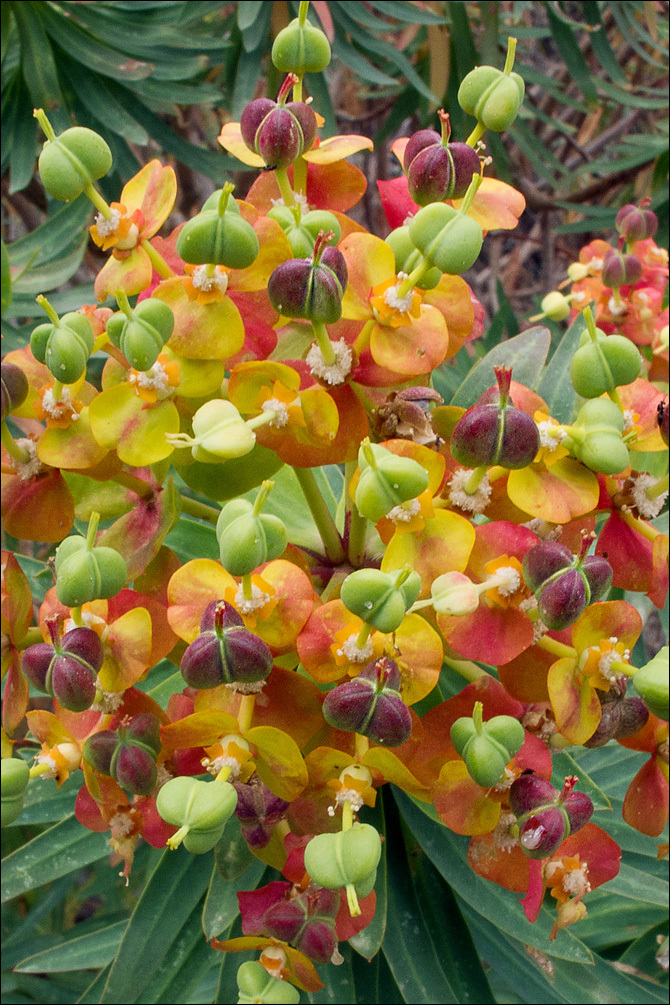
Slo.: no name. - Habitat: stony mountain ravine close to sea shore, calcareous ground, full sun, warm place, south to east aspect, elevation 270 m (890 feet); average precipitations ~ 960 mm/year, average temperature about 18 deg C, Mediterranean phytogeographical region. Substratum: soil among rocks. Comment: Genus Euphorbia is huge. All kind of imaginable plants constitute it. In North and Central Europe they are mostly small and herbaceous and more to the south one goes, more species are woody, bush and tree like. Many of them are very beautiful, either from the standpoint of colors or shapes of leaves or their unusually built flowers. Euphorbia dendroides is spread in all Mediterranean countries except Cyprus. It is one of the most beautiful woody species. Particularly the colors of their flowers and leaves, which are yellow and green in early spring, impress. Toward the end of springtime when higher and higher temperatures and drought push forth they change their color to all kind of orange, red, wine red, brown-violet, before they fall off in summer. Large, up to 2.5 m high, rounded bushes, often forming large colonies in more or less barren rocky mountain slopes turn to marvelous vistas. My trip to this steep, wild, incredible thorny, trail-less ravine of peninsula Korykos in northwest Crete was an unforgettable experience Ref.: (1) I. Schnfelder, P. Schnfelder, Kosmos Atlas Mittelmeer- und Kanarenflora, Kosmos, (2002), p 106. (2) V. Popiomytoglou, Woldblumen Griechenland, Mediterraneo Edition (2006), p 89. (3) M. Blamey, C. Grey-Wilson, Wild Flowers of the Mediterranean, A & C Black, London (2005), p 118. (4) R. Domac, Flora Hrvatske (Flora of Croatia) (in Croatian), kolska Knjiga, Zagreb (1994), p 61. (5) D. Seidel, Blumen am Mittelmeer, BLV (2002), p 215.
-
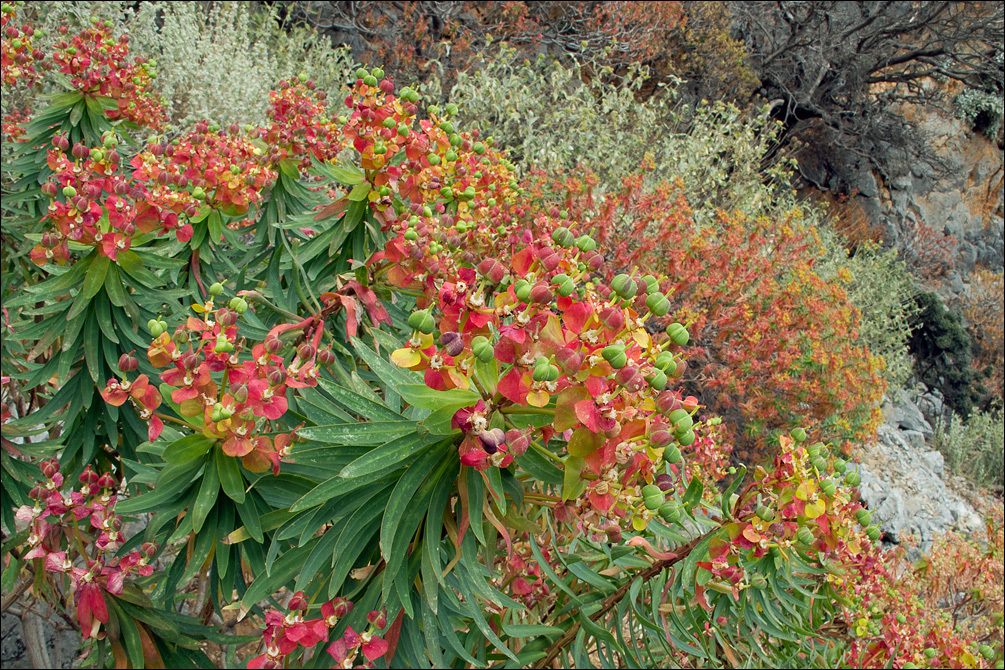
Slo.: no name. - Habitat: stony mountain ravine close to sea shore, calcareous ground, full sun, warm place, south to east aspect, elevation 270 m (890 feet); average precipitations ~ 960 mm/year, average temperature about 18 deg C, Mediterranean phytogeographical region. Substratum: soil among rocks. Comment: Genus Euphorbia is huge. All kind of imaginable plants constitute it. In North and Central Europe they are mostly small and herbaceous and more to the south one goes, more species are woody, bush and tree like. Many of them are very beautiful, either from the standpoint of colors or shapes of leaves or their unusually built flowers. Euphorbia dendroides is spread in all Mediterranean countries except Cyprus. It is one of the most beautiful woody species. Particularly the colors of their flowers and leaves, which are yellow and green in early spring, impress. Toward the end of springtime when higher and higher temperatures and drought push forth they change their color to all kind of orange, red, wine red, brown-violet, before they fall off in summer. Large, up to 2.5 m high, rounded bushes, often forming large colonies in more or less barren rocky mountain slopes turn to marvelous vistas. My trip to this steep, wild, incredible thorny, trail-less ravine of peninsula Korykos in northwest Crete was an unforgettable experience Ref.: (1) I. Schnfelder, P. Schnfelder, Kosmos Atlas Mittelmeer- und Kanarenflora, Kosmos, (2002), p 106. (2) V. Popiomytoglou, Woldblumen Griechenland, Mediterraneo Edition (2006), p 89. (3) M. Blamey, C. Grey-Wilson, Wild Flowers of the Mediterranean, A & C Black, London (2005), p 118. (4) R. Domac, Flora Hrvatske (Flora of Croatia) (in Croatian), kolska Knjiga, Zagreb (1994), p 61. (5) D. Seidel, Blumen am Mittelmeer, BLV (2002), p 215.
-

Slo.: no name. - Habitat: stony mountain ravine close to sea shore, calcareous ground, full sun, warm place, south to east aspect, elevation 270 m (890 feet); average precipitations ~ 960 mm/year, average temperature about 18 deg C, Mediterranean phytogeographical region. Substratum: soil among rocks. Comment: Genus Euphorbia is huge. All kind of imaginable plants constitute it. In North and Central Europe they are mostly small and herbaceous and more to the south one goes, more species are woody, bush and tree like. Many of them are very beautiful, either from the standpoint of colors or shapes of leaves or their unusually built flowers. Euphorbia dendroides is spread in all Mediterranean countries except Cyprus. It is one of the most beautiful woody species. Particularly the colors of their flowers and leaves, which are yellow and green in early spring, impress. Toward the end of springtime when higher and higher temperatures and drought push forth they change their color to all kind of orange, red, wine red, brown-violet, before they fall off in summer. Large, up to 2.5 m high, rounded bushes, often forming large colonies in more or less barren rocky mountain slopes turn to marvelous vistas. My trip to this steep, wild, incredible thorny, trail-less ravine of peninsula Korykos in northwest Crete was an unforgettable experience Ref.: (1) I. Schnfelder, P. Schnfelder, Kosmos Atlas Mittelmeer- und Kanarenflora, Kosmos, (2002), p 106. (2) V. Popiomytoglou, Woldblumen Griechenland, Mediterraneo Edition (2006), p 89. (3) M. Blamey, C. Grey-Wilson, Wild Flowers of the Mediterranean, A & C Black, London (2005), p 118. (4) R. Domac, Flora Hrvatske (Flora of Croatia) (in Croatian), kolska Knjiga, Zagreb (1994), p 61. (5) D. Seidel, Blumen am Mittelmeer, BLV (2002), p 215.
-
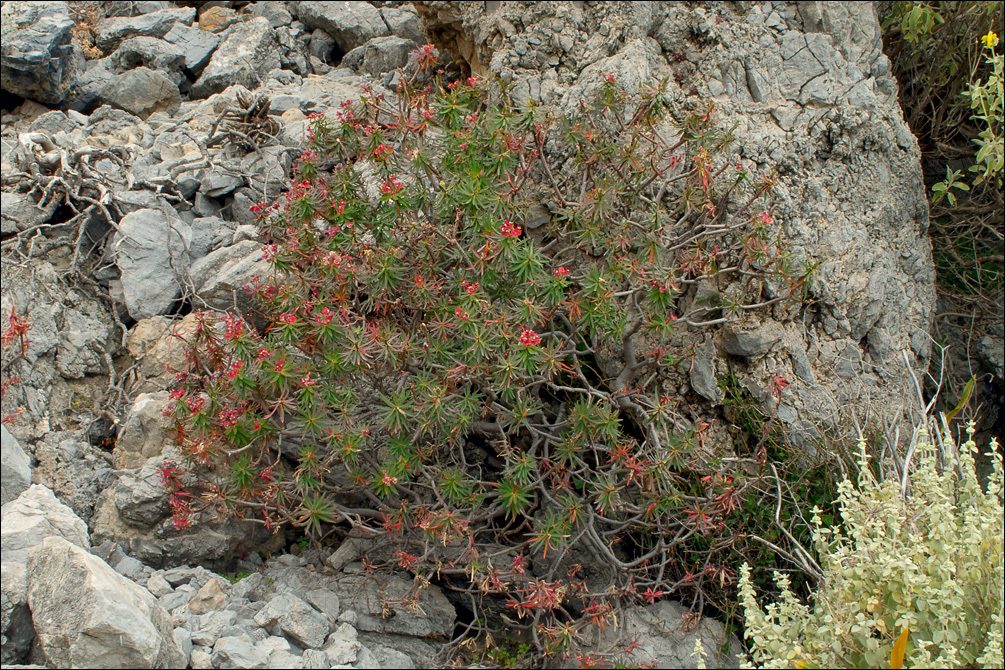
Slo.: no name. - Habitat: stony mountain ravine close to sea shore, calcareous ground, full sun, warm place, south to east aspect, elevation 270 m (890 feet); average precipitations ~ 960 mm/year, average temperature about 18 deg C, Mediterranean phytogeographical region. Substratum: soil among rocks. Comment: Genus Euphorbia is huge. All kind of imaginable plants constitute it. In North and Central Europe they are mostly small and herbaceous and more to the south one goes, more species are woody, bush and tree like. Many of them are very beautiful, either from the standpoint of colors or shapes of leaves or their unusually built flowers. Euphorbia dendroides is spread in all Mediterranean countries except Cyprus. It is one of the most beautiful woody species. Particularly the colors of their flowers and leaves, which are yellow and green in early spring, impress. Toward the end of springtime when higher and higher temperatures and drought push forth they change their color to all kind of orange, red, wine red, brown-violet, before they fall off in summer. Large, up to 2.5 m high, rounded bushes, often forming large colonies in more or less barren rocky mountain slopes turn to marvelous vistas. My trip to this steep, wild, incredible thorny, trail-less ravine of peninsula Korykos in northwest Crete was an unforgettable experience Ref.: (1) I. Schnfelder, P. Schnfelder, Kosmos Atlas Mittelmeer- und Kanarenflora, Kosmos, (2002), p 106. (2) V. Popiomytoglou, Woldblumen Griechenland, Mediterraneo Edition (2006), p 89. (3) M. Blamey, C. Grey-Wilson, Wild Flowers of the Mediterranean, A & C Black, London (2005), p 118. (4) R. Domac, Flora Hrvatske (Flora of Croatia) (in Croatian), kolska Knjiga, Zagreb (1994), p 61. (5) D. Seidel, Blumen am Mittelmeer, BLV (2002), p 215.
-
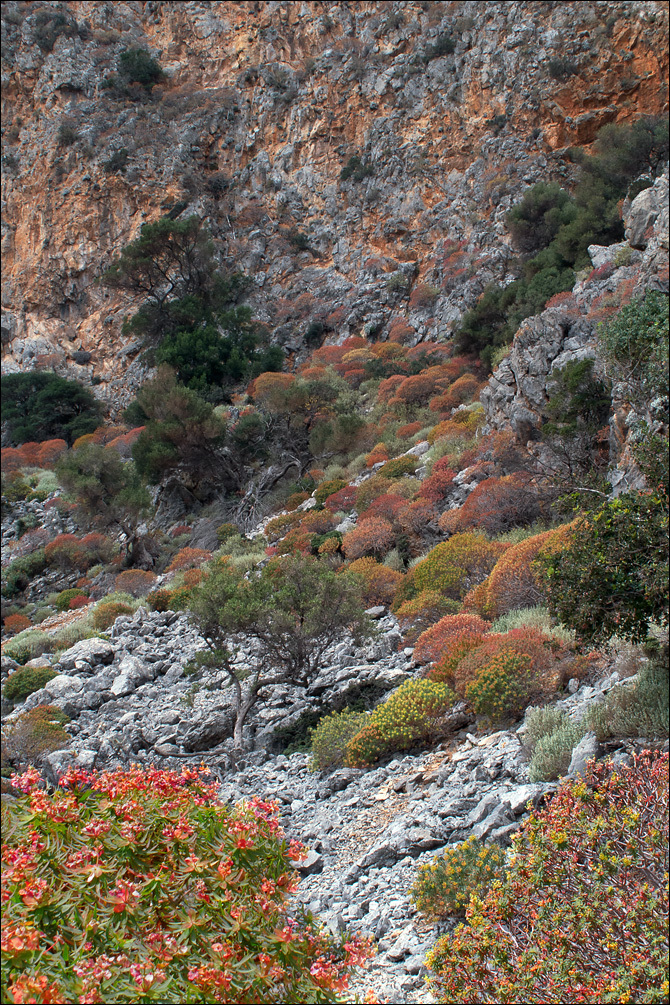
Slo.: no name. - Habitat: stony mountain ravine close to sea shore, calcareous ground, full sun, warm place, south to east aspect, elevation 270 m (890 feet); average precipitations ~ 960 mm/year, average temperature about 18 deg C, Mediterranean phytogeographical region. Substratum: soil among rocks. Comment: Genus Euphorbia is huge. All kind of imaginable plants constitute it. In North and Central Europe they are mostly small and herbaceous and more to the south one goes, more species are woody, bush and tree like. Many of them are very beautiful, either from the standpoint of colors or shapes of leaves or their unusually built flowers. Euphorbia dendroides is spread in all Mediterranean countries except Cyprus. It is one of the most beautiful woody species. Particularly the colors of their flowers and leaves, which are yellow and green in early spring, impress. Toward the end of springtime when higher and higher temperatures and drought push forth they change their color to all kind of orange, red, wine red, brown-violet, before they fall off in summer. Large, up to 2.5 m high, rounded bushes, often forming large colonies in more or less barren rocky mountain slopes turn to marvelous vistas. My trip to this steep, wild, incredible thorny, trail-less ravine of peninsula Korykos in northwest Crete was an unforgettable experience Ref.: (1) I. Schnfelder, P. Schnfelder, Kosmos Atlas Mittelmeer- und Kanarenflora, Kosmos, (2002), p 106. (2) V. Popiomytoglou, Woldblumen Griechenland, Mediterraneo Edition (2006), p 89. (3) M. Blamey, C. Grey-Wilson, Wild Flowers of the Mediterranean, A & C Black, London (2005), p 118. (4) R. Domac, Flora Hrvatske (Flora of Croatia) (in Croatian), kolska Knjiga, Zagreb (1994), p 61. (5) D. Seidel, Blumen am Mittelmeer, BLV (2002), p 215.
-
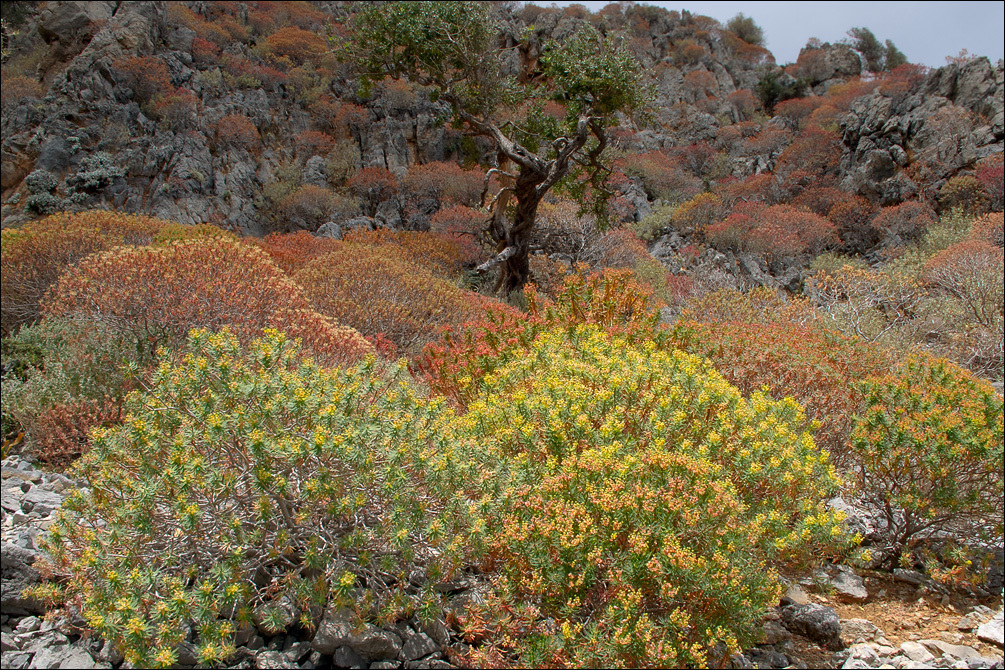
Slo.: no name. - Habitat: stony mountain ravine close to sea shore, calcareous ground, full sun, warm place, south to east aspect, elevation 270 m (890 feet); average precipitations ~ 960 mm/year, average temperature about 18 deg C, Mediterranean phytogeographical region. Substratum: soil among rocks. Comment: Genus Euphorbia is huge. All kind of imaginable plants constitute it. In North and Central Europe they are mostly small and herbaceous and more to the south one goes, more species are woody, bush and tree like. Many of them are very beautiful, either from the standpoint of colors or shapes of leaves or their unusually built flowers. Euphorbia dendroides is spread in all Mediterranean countries except Cyprus. It is one of the most beautiful woody species. Particularly the colors of their flowers and leaves, which are yellow and green in early spring, impress. Toward the end of springtime when higher and higher temperatures and drought push forth they change their color to all kind of orange, red, wine red, brown-violet, before they fall off in summer. Large, up to 2.5 m high, rounded bushes, often forming large colonies in more or less barren rocky mountain slopes turn to marvelous vistas. My trip to this steep, wild, incredible thorny, trail-less ravine of peninsula Korykos in northwest Crete was an unforgettable experience Ref.: (1) I. Schnfelder, P. Schnfelder, Kosmos Atlas Mittelmeer- und Kanarenflora, Kosmos, (2002), p 106. (2) V. Popiomytoglou, Woldblumen Griechenland, Mediterraneo Edition (2006), p 89. (3) M. Blamey, C. Grey-Wilson, Wild Flowers of the Mediterranean, A & C Black, London (2005), p 118. (4) R. Domac, Flora Hrvatske (Flora of Croatia) (in Croatian), kolska Knjiga, Zagreb (1994), p 61. (5) D. Seidel, Blumen am Mittelmeer, BLV (2002), p 215.
-
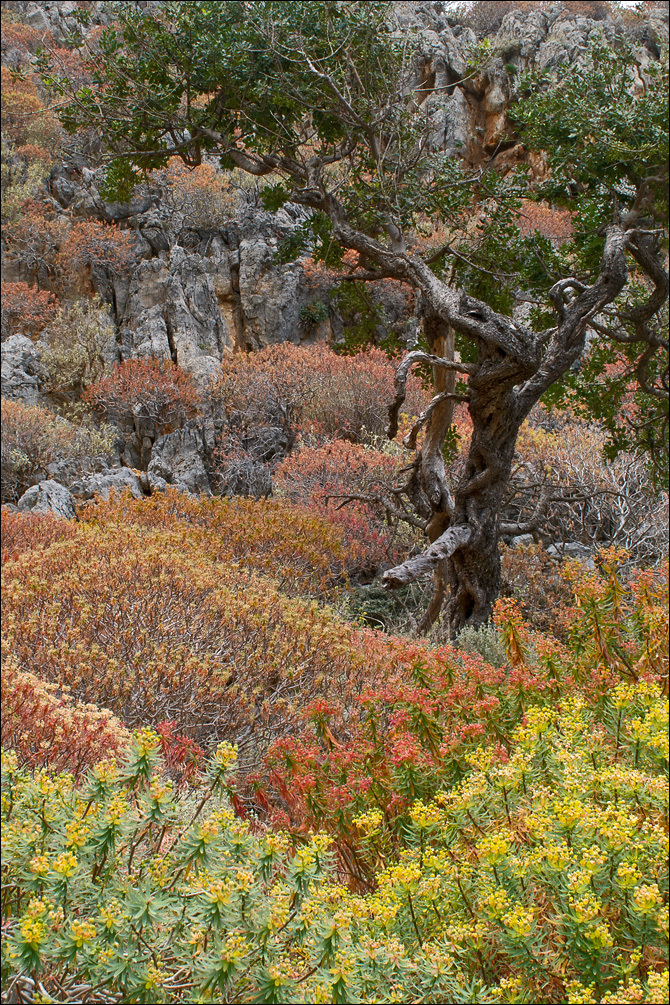
Slo.: no name. - Habitat: stony mountain ravine close to sea shore, calcareous ground, full sun, warm place, south to east aspect, elevation 270 m (890 feet); average precipitations ~ 960 mm/year, average temperature about 18 deg C, Mediterranean phytogeographical region. Substratum: soil among rocks. Comment: Genus Euphorbia is huge. All kind of imaginable plants constitute it. In North and Central Europe they are mostly small and herbaceous and more to the south one goes, more species are woody, bush and tree like. Many of them are very beautiful, either from the standpoint of colors or shapes of leaves or their unusually built flowers. Euphorbia dendroides is spread in all Mediterranean countries except Cyprus. It is one of the most beautiful woody species. Particularly the colors of their flowers and leaves, which are yellow and green in early spring, impress. Toward the end of springtime when higher and higher temperatures and drought push forth they change their color to all kind of orange, red, wine red, brown-violet, before they fall off in summer. Large, up to 2.5 m high, rounded bushes, often forming large colonies in more or less barren rocky mountain slopes turn to marvelous vistas. My trip to this steep, wild, incredible thorny, trail-less ravine of peninsula Korykos in northwest Crete was an unforgettable experience Ref.: (1) I. Schnfelder, P. Schnfelder, Kosmos Atlas Mittelmeer- und Kanarenflora, Kosmos, (2002), p 106. (2) V. Popiomytoglou, Woldblumen Griechenland, Mediterraneo Edition (2006), p 89. (3) M. Blamey, C. Grey-Wilson, Wild Flowers of the Mediterranean, A & C Black, London (2005), p 118. (4) R. Domac, Flora Hrvatske (Flora of Croatia) (in Croatian), kolska Knjiga, Zagreb (1994), p 61. (5) D. Seidel, Blumen am Mittelmeer, BLV (2002), p 215.
-

Slo.: no name. - Habitat: stony mountain ravine close to sea shore, calcareous ground, full sun, warm place, south to east aspect, elevation 270 m (890 feet); average precipitations ~ 960 mm/year, average temperature about 18 deg C, Mediterranean phytogeographical region. Substratum: soil among rocks. Comment: Genus Euphorbia is huge. All kind of imaginable plants constitute it. In North and Central Europe they are mostly small and herbaceous and more to the south one goes, more species are woody, bush and tree like. Many of them are very beautiful, either from the standpoint of colors or shapes of leaves or their unusually built flowers. Euphorbia dendroides is spread in all Mediterranean countries except Cyprus. It is one of the most beautiful woody species. Particularly the colors of their flowers and leaves, which are yellow and green in early spring, impress. Toward the end of springtime when higher and higher temperatures and drought push forth they change their color to all kind of orange, red, wine red, brown-violet, before they fall off in summer. Large, up to 2.5 m high, rounded bushes, often forming large colonies in more or less barren rocky mountain slopes turn to marvelous vistas. My trip to this steep, wild, incredible thorny, trail-less ravine of peninsula Korykos in northwest Crete was an unforgettable experience Ref.: (1) I. Schnfelder, P. Schnfelder, Kosmos Atlas Mittelmeer- und Kanarenflora, Kosmos, (2002), p 106. (2) V. Popiomytoglou, Woldblumen Griechenland, Mediterraneo Edition (2006), p 89. (3) M. Blamey, C. Grey-Wilson, Wild Flowers of the Mediterranean, A & C Black, London (2005), p 118. (4) R. Domac, Flora Hrvatske (Flora of Croatia) (in Croatian), kolska Knjiga, Zagreb (1994), p 61. (5) D. Seidel, Blumen am Mittelmeer, BLV (2002), p 215.
-
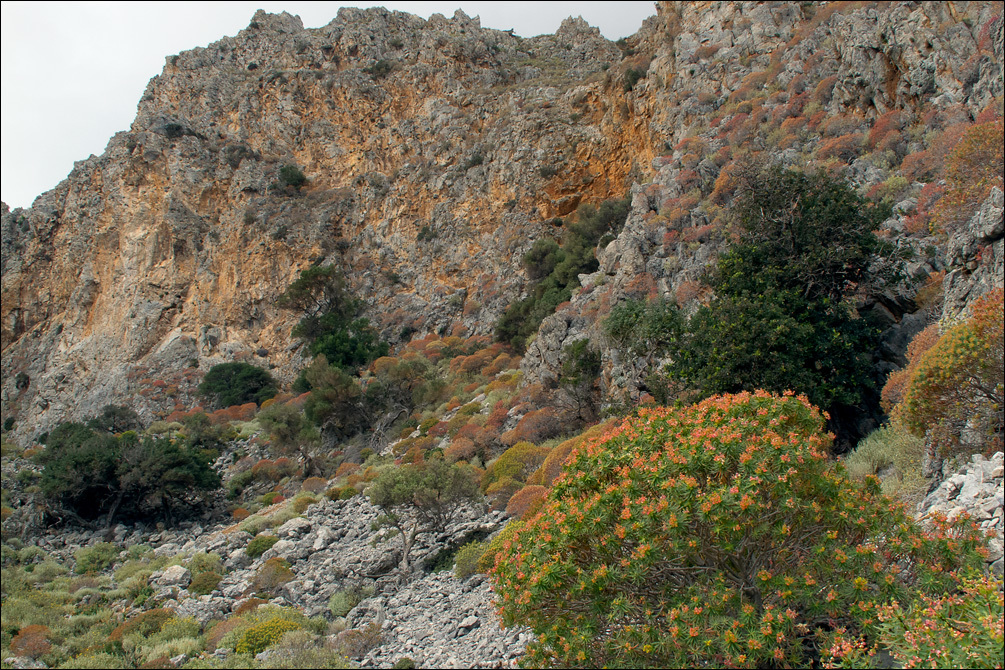
Slo.: no name. - Habitat: stony mountain ravine close to sea shore, calcareous ground, full sun, warm place, south to east aspect, elevation 270 m (890 feet); average precipitations ~ 960 mm/year, average temperature about 18 deg C, Mediterranean phytogeographical region. Substratum: soil among rocks. Comment: Genus Euphorbia is huge. All kind of imaginable plants constitute it. In North and Central Europe they are mostly small and herbaceous and more to the south one goes, more species are woody, bush and tree like. Many of them are very beautiful, either from the standpoint of colors or shapes of leaves or their unusually built flowers. Euphorbia dendroides is spread in all Mediterranean countries except Cyprus. It is one of the most beautiful woody species. Particularly the colors of their flowers and leaves, which are yellow and green in early spring, impress. Toward the end of springtime when higher and higher temperatures and drought push forth they change their color to all kind of orange, red, wine red, brown-violet, before they fall off in summer. Large, up to 2.5 m high, rounded bushes, often forming large colonies in more or less barren rocky mountain slopes turn to marvelous vistas. My trip to this steep, wild, incredible thorny, trail-less ravine of peninsula Korykos in northwest Crete was an unforgettable experience Ref.: (1) I. Schnfelder, P. Schnfelder, Kosmos Atlas Mittelmeer- und Kanarenflora, Kosmos, (2002), p 106. (2) V. Popiomytoglou, Woldblumen Griechenland, Mediterraneo Edition (2006), p 89. (3) M. Blamey, C. Grey-Wilson, Wild Flowers of the Mediterranean, A & C Black, London (2005), p 118. (4) R. Domac, Flora Hrvatske (Flora of Croatia) (in Croatian), kolska Knjiga, Zagreb (1994), p 61. (5) D. Seidel, Blumen am Mittelmeer, BLV (2002), p 215.
-
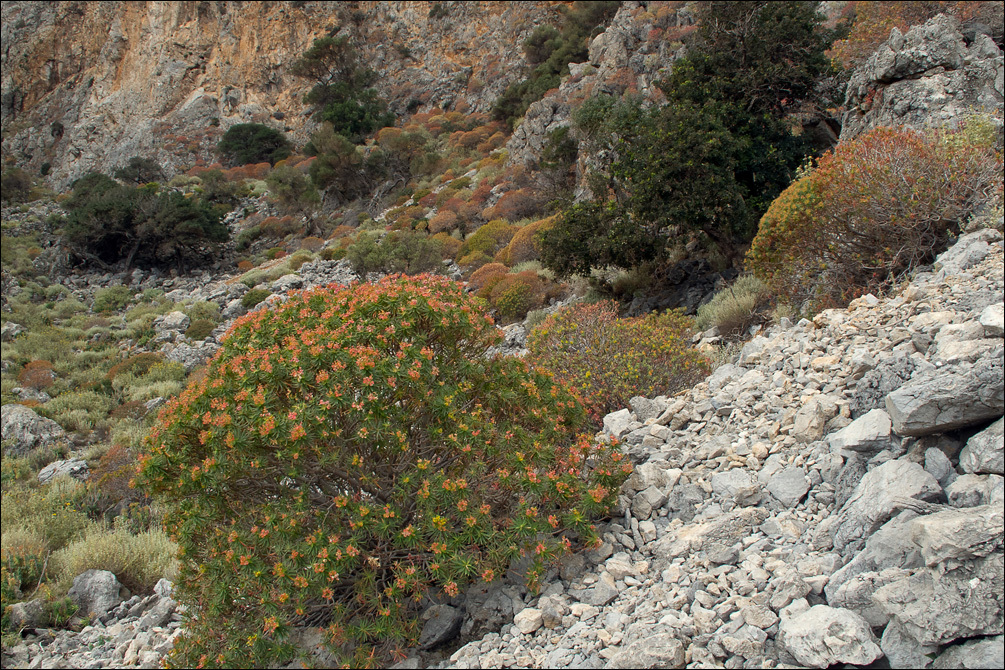
Slo.: no name. - Habitat: stony mountain ravine close to sea shore, calcareous ground, full sun, warm place, south to east aspect, elevation 270 m (890 feet); average precipitations ~ 960 mm/year, average temperature about 18 deg C, Mediterranean phytogeographical region. Substratum: soil among rocks. Comment: Genus Euphorbia is huge. All kind of imaginable plants constitute it. In North and Central Europe they are mostly small and herbaceous and more to the south one goes, more species are woody, bush and tree like. Many of them are very beautiful, either from the standpoint of colors or shapes of leaves or their unusually built flowers. Euphorbia dendroides is spread in all Mediterranean countries except Cyprus. It is one of the most beautiful woody species. Particularly the colors of their flowers and leaves, which are yellow and green in early spring, impress. Toward the end of springtime when higher and higher temperatures and drought push forth they change their color to all kind of orange, red, wine red, brown-violet, before they fall off in summer. Large, up to 2.5 m high, rounded bushes, often forming large colonies in more or less barren rocky mountain slopes turn to marvelous vistas. My trip to this steep, wild, incredible thorny, trail-less ravine of peninsula Korykos in northwest Crete was an unforgettable experience Ref.: (1) I. Schnfelder, P. Schnfelder, Kosmos Atlas Mittelmeer- und Kanarenflora, Kosmos, (2002), p 106. (2) V. Popiomytoglou, Woldblumen Griechenland, Mediterraneo Edition (2006), p 89. (3) M. Blamey, C. Grey-Wilson, Wild Flowers of the Mediterranean, A & C Black, London (2005), p 118. (4) R. Domac, Flora Hrvatske (Flora of Croatia) (in Croatian), kolska Knjiga, Zagreb (1994), p 61. (5) D. Seidel, Blumen am Mittelmeer, BLV (2002), p 215.
-
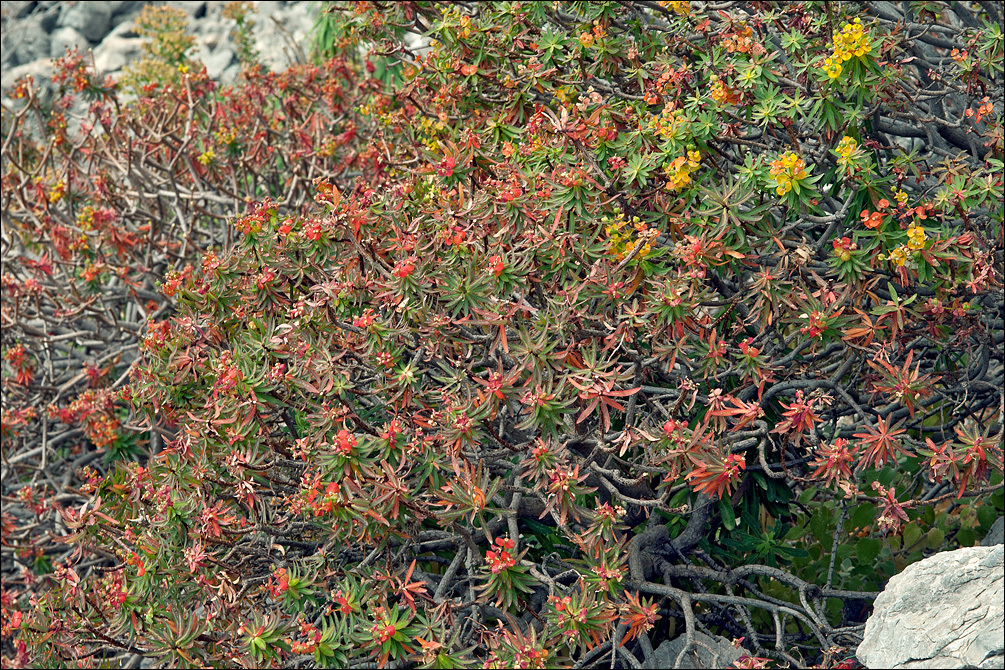
Slo.: no name. - Habitat: stony mountain ravine close to sea shore, calcareous ground, full sun, warm place, south to east aspect, elevation 270 m (890 feet); average precipitations ~ 960 mm/year, average temperature about 18 deg C, Mediterranean phytogeographical region. Substratum: soil among rocks. Comment: Genus Euphorbia is huge. All kind of imaginable plants constitute it. In North and Central Europe they are mostly small and herbaceous and more to the south one goes, more species are woody, bush and tree like. Many of them are very beautiful, either from the standpoint of colors or shapes of leaves or their unusually built flowers. Euphorbia dendroides is spread in all Mediterranean countries except Cyprus. It is one of the most beautiful woody species. Particularly the colors of their flowers and leaves, which are yellow and green in early spring, impress. Toward the end of springtime when higher and higher temperatures and drought push forth they change their color to all kind of orange, red, wine red, brown-violet, before they fall off in summer. Large, up to 2.5 m high, rounded bushes, often forming large colonies in more or less barren rocky mountain slopes turn to marvelous vistas. My trip to this steep, wild, incredible thorny, trail-less ravine of peninsula Korykos in northwest Crete was an unforgettable experience Ref.: (1) I. Schnfelder, P. Schnfelder, Kosmos Atlas Mittelmeer- und Kanarenflora, Kosmos, (2002), p 106. (2) V. Popiomytoglou, Woldblumen Griechenland, Mediterraneo Edition (2006), p 89. (3) M. Blamey, C. Grey-Wilson, Wild Flowers of the Mediterranean, A & C Black, London (2005), p 118. (4) R. Domac, Flora Hrvatske (Flora of Croatia) (in Croatian), kolska Knjiga, Zagreb (1994), p 61. (5) D. Seidel, Blumen am Mittelmeer, BLV (2002), p 215.
-
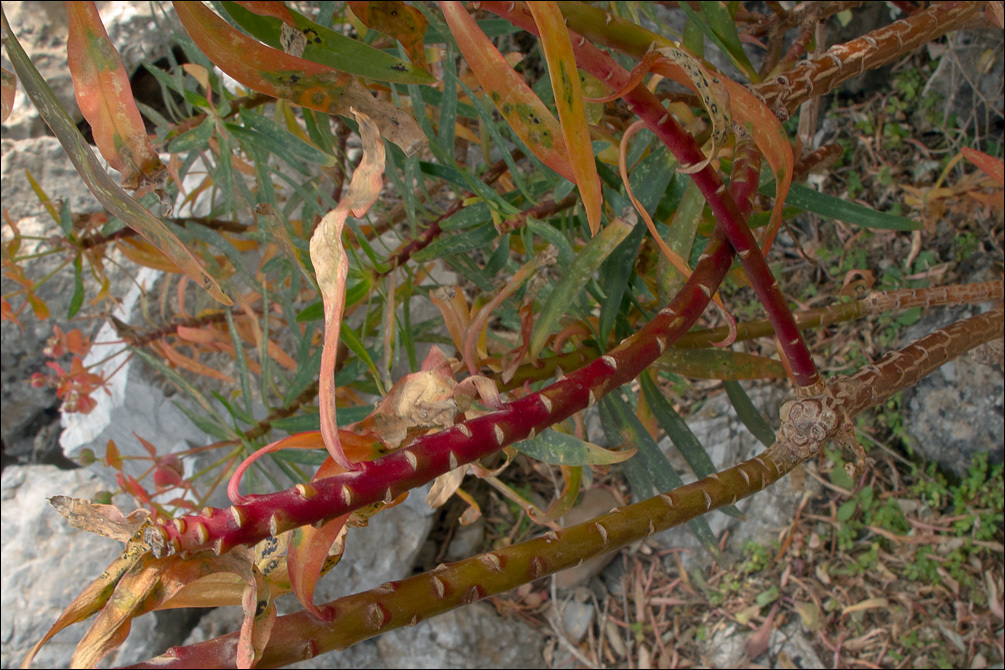
Slo.: no name. - Habitat: stony mountain ravine close to sea shore, calcareous ground, full sun, warm place, south to east aspect, elevation 270 m (890 feet); average precipitations ~ 960 mm/year, average temperature about 18 deg C, Mediterranean phytogeographical region. Substratum: soil among rocks. Comment: Genus Euphorbia is huge. All kind of imaginable plants constitute it. In North and Central Europe they are mostly small and herbaceous and more to the south one goes, more species are woody, bush and tree like. Many of them are very beautiful, either from the standpoint of colors or shapes of leaves or their unusually built flowers. Euphorbia dendroides is spread in all Mediterranean countries except Cyprus. It is one of the most beautiful woody species. Particularly the colors of their flowers and leaves, which are yellow and green in early spring, impress. Toward the end of springtime when higher and higher temperatures and drought push forth they change their color to all kind of orange, red, wine red, brown-violet, before they fall off in summer. Large, up to 2.5 m high, rounded bushes, often forming large colonies in more or less barren rocky mountain slopes turn to marvelous vistas. My trip to this steep, wild, incredible thorny, trail-less ravine of peninsula Korykos in northwest Crete was an unforgettable experience Ref.: (1) I. Schnfelder, P. Schnfelder, Kosmos Atlas Mittelmeer- und Kanarenflora, Kosmos, (2002), p 106. (2) V. Popiomytoglou, Woldblumen Griechenland, Mediterraneo Edition (2006), p 89. (3) M. Blamey, C. Grey-Wilson, Wild Flowers of the Mediterranean, A & C Black, London (2005), p 118. (4) R. Domac, Flora Hrvatske (Flora of Croatia) (in Croatian), kolska Knjiga, Zagreb (1994), p 61. (5) D. Seidel, Blumen am Mittelmeer, BLV (2002), p 215.
-
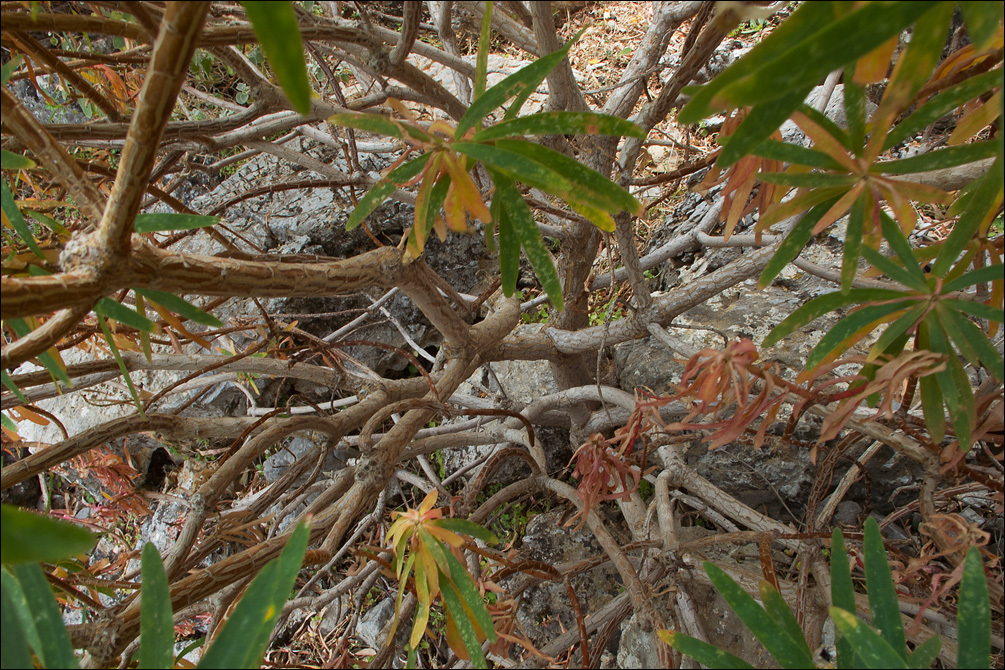
Slo.: no name. - Habitat: stony mountain ravine close to sea shore, calcareous ground, full sun, warm place, south to east aspect, elevation 270 m (890 feet); average precipitations ~ 960 mm/year, average temperature about 18 deg C, Mediterranean phytogeographical region. Substratum: soil among rocks. Comment: Genus Euphorbia is huge. All kind of imaginable plants constitute it. In North and Central Europe they are mostly small and herbaceous and more to the south one goes, more species are woody, bush and tree like. Many of them are very beautiful, either from the standpoint of colors or shapes of leaves or their unusually built flowers. Euphorbia dendroides is spread in all Mediterranean countries except Cyprus. It is one of the most beautiful woody species. Particularly the colors of their flowers and leaves, which are yellow and green in early spring, impress. Toward the end of springtime when higher and higher temperatures and drought push forth they change their color to all kind of orange, red, wine red, brown-violet, before they fall off in summer. Large, up to 2.5 m high, rounded bushes, often forming large colonies in more or less barren rocky mountain slopes turn to marvelous vistas. My trip to this steep, wild, incredible thorny, trail-less ravine of peninsula Korykos in northwest Crete was an unforgettable experience Ref.: (1) I. Schnfelder, P. Schnfelder, Kosmos Atlas Mittelmeer- und Kanarenflora, Kosmos, (2002), p 106. (2) V. Popiomytoglou, Woldblumen Griechenland, Mediterraneo Edition (2006), p 89. (3) M. Blamey, C. Grey-Wilson, Wild Flowers of the Mediterranean, A & C Black, London (2005), p 118. (4) R. Domac, Flora Hrvatske (Flora of Croatia) (in Croatian), kolska Knjiga, Zagreb (1994), p 61. (5) D. Seidel, Blumen am Mittelmeer, BLV (2002), p 215.
-
N Koutsomatados, W-Crete, Greece
-
Aptera, E of Chania, Greece
-
N Koutsomatados, W-Crete, Greece
-
N Koutsomatados, W-Crete, Greece
-
-

